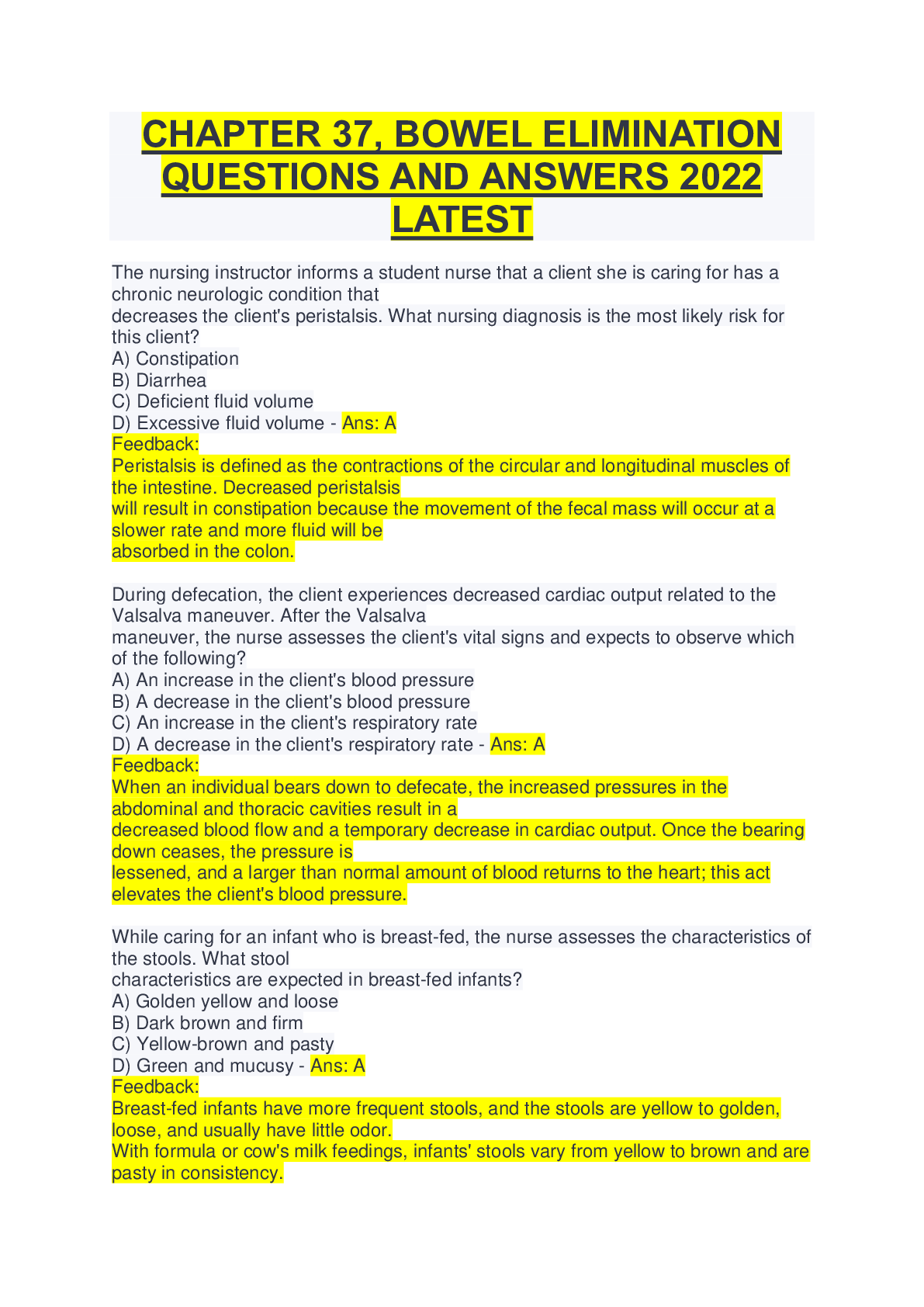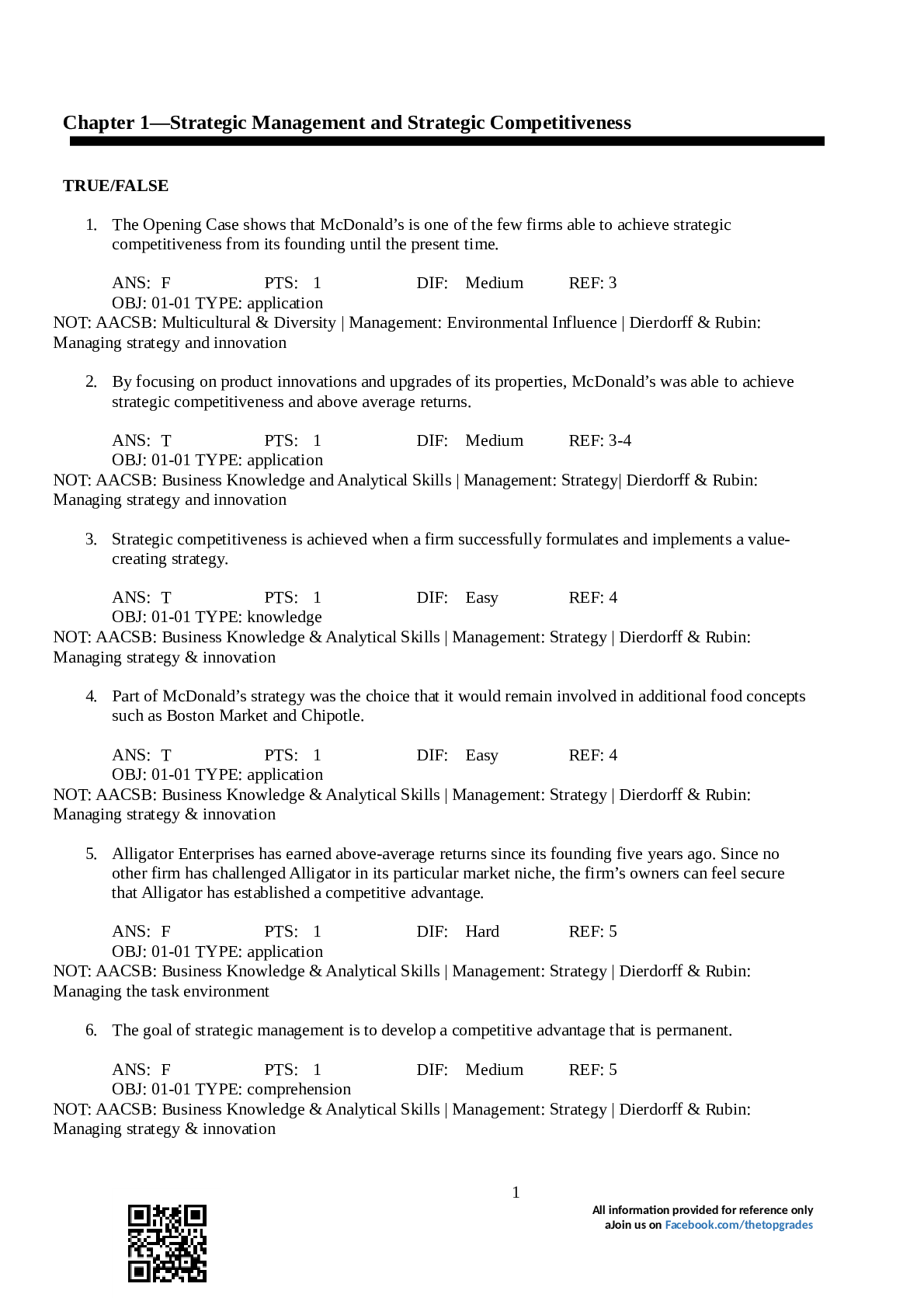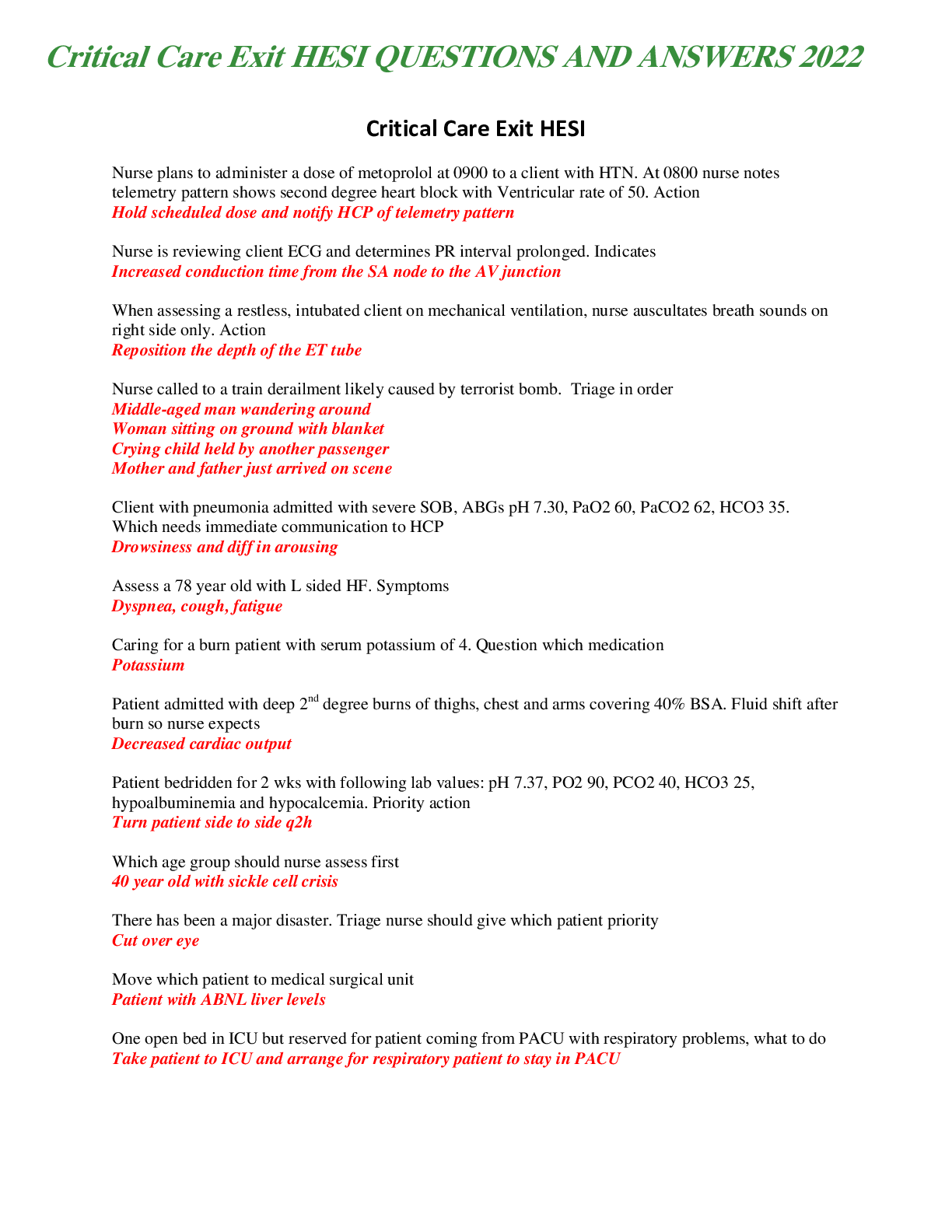CHAPTER 37, BOWEL ELIMINATION QUESTIONS AND ANSWERS 2022 LATEST
Document Content and Description Below
CHAPTER 37, BOWEL ELIMINATION QUESTIONS AND ANSWERS 2022 LATEST The nursing instructor informs a student nurse that a client she is caring for has a chronic neurologic condition that decreases ... the client's peristalsis. What nursing diagnosis is the most likely risk for this client? A) Constipation B) Diarrhea C) Deficient fluid volume D) Excessive fluid volume - Ans: A Feedback: Peristalsis is defined as the contractions of the circular and longitudinal muscles of the intestine. Decreased peristalsis will result in constipation because the movement of the fecal mass will occur at a slower rate and more fluid will be absorbed in the colon. During defecation, the client experiences decreased cardiac output related to the Valsalva maneuver. After the Valsalva maneuver, the nurse assesses the client's vital signs and expects to observe which of the following? A) An increase in the client's blood pressure B) A decrease in the client's blood pressure C) An increase in the client's respiratory rate D) A decrease in the client's respiratory rate - Ans: A Feedback: When an individual bears down to defecate, the increased pressures in the abdominal and thoracic cavities result in a decreased blood flow and a temporary decrease in cardiac output. Once the bearing down ceases, the pressure is lessened, and a larger than normal amount of blood returns to the heart; this act elevates the client's blood pressure. While caring for an infant who is breast-fed, the nurse assesses the characteristics of the stools. What stool characteristics are expected in breast-fed infants? A) Golden yellow and loose B) Dark brown and firm C) Yellow-brown and pasty D) Green and mucusy - Ans: A Feedback: Breast-fed infants have more frequent stools, and the stools are yellow to golden, loose, and usually have little odor. With formula or cow's milk feedings, infants' stools vary from yellow to brown and are pasty in consistency. Which type of stool would the nurse assess in a client with an illness that causes the stool to pass through the large intestine quickly? A) Hard, formed B) Black, tarry C) Soft, watery D) Dry, odorous - Ans: C Feedback: About 800 to 1,000 mL of liquid is absorbed daily by the large intestine. When absorption does not occur properly, such as when the waste products pass through the large intestine rapidly, the stool is soft and watery. A nurse is assessing the stools of a breastfed baby. What is the appearance of normal stools for this baby? A) Yellow, loose, odorless B) Brown, paste-like, some odor C) Brown, formed, strong odor D) Black, semiformed, no odor - Ans: A Feedback: Breast-fed babies have more frequent stools, and the stools are yellow to golden and loose, usually with little odor. Breast-fed babies can normally have 2 to 10 stools per day. A hospitalized toddler, previously bowel trained, has been having incontinent stools. What would the nurse tell the parents about this behavior? A) "When he does this, scold him and he will quit." B) "I don't understand why this child is losing control." C) "This is normal when a child this age is hospitalized." D) "I will have to call the doctor and report this behavior." - Ans: C Feedback: Discourage the use of punishment or shame for elimination accidents. Toddlers who are toilet trained often regress and experience soiling when hospitalized, and scolding or acting disgusted only reinforces the behavior. A client is having difficulty having a bowel movement on the bedpan. What is the physiologic reason for this problem? A) It is painful to sit on a bedpan. B) The position does not facilitate downward pressure. C) The position encourages the Valsalva maneuver. D) The cause is unknown and requires further study. - Ans: B Feedback: Most people assume the squatting or slightly forward-sitting position with the thighs flexed to defecate. These positions result in increased pressure on the abdomen and downward pressure on the rectum to facilitate defecation. Obtaining the same results when seated on a bedpan is difficult. The following foods are a part of a client's daily diet: high-fiber cereals, fruits, vegetables, 2,500 mL of fluids. What would the nurse tell the client to change? A) Decrease high-fiber foods B) Decrease amount of fluids C) Omit fruits if eating vegetables D) Nothing; this is a good diet - Ans: D Feedback: A high-fiber diet and a daily fluid intake of 2,500 to 3,000 mL of fluids facilitate bowel elimination. Intake of the foods described makes the feces more bulky, so they move through the intestine more quickly. The stool is softer and the time to absorb toxins is decreased (toxins are believed to have a role in the development of colon cancer). A young woman comes to the emergency department with severe abdominal cramping and frequent bloody stools. Food poisoning is suspected. What diagnostic test would be used to confirm this diagnosis? A) Routine urinalysis B) Chest x-ray C) Stool sample D) Sputum sample - Ans: C Feedback: Outbreaks of food poisoning can result in severe gastrointestinal symptoms. Severe abdominal cramping followed by watery or bloody diarrhea may signal a microbial infection, which can be confirmed by a stool sample. A nurse is conducting an abdominal assessment. What is the rationale for palpating the abdomen last in the sequence when conducting an abdominal assessment? A) It is the most painful assessment method B) It is the most embarrassing assessment method C) To allow time for the examiner's hands to warm D) It disturbs normal peristalsis and bowel motility - Ans: D Feedback: The sequence for abdominal assessment is inspection, auscultation, percussion, and palpation. Inspection and auscultation are performed before palpation because palpation may disturb normal peristalsis and bowel motility. What are two essential techniques when collecting a stool specimen? A) Hand hygiene and wearing gloves B) Following policies and selecting containers C) Wearing goggles and an isolation gown D) Using a no-touch method and toilet paper - Ans: A Feedback: Use of medical aseptic techniques when collecting a stool specimen is imperative. Hand hygiene, before and after wearing rubber gloves, is essential. What is occult blood? A) Bright red visible blood B) Dark black visible blood C) Blood that contains mucus D) Blood that cannot be seen - Ans: D Feedback: Occult blood in the stool is blood that is hidden in the specimen or cannot be seen on gross examination. It can be detected with simple screening tests, such as a Hematest. A nurse is scheduling diagnostic studies for client. Which test would be performed first? A) Fecal occult blood test B) Barium study C) Endoscopic exam D) Upper gastrointestinal series - Ans: A Feedback: Nurses are commonly involved in scheduling diagnostic studies when a client is to undergo multiple studies. They should follow a logical sequence when more than one test is required for accurate diagnosis; that is, fecal occult blood tests to detect gastrointestinal bleeding; barium studies to visualize gastrointestinal structures and reveal any inflammation, ulcers, tumors, strictures, or other lesions; and endoscopic examinations to visualize an abnormality, locate a source of bleeding, and if necessary, provide biopsy tissue samples. A client has had frequent watery stools (diarrhea) for an extended period of time. The client also has decreased skin turgor and dark urine. Based on these data, which nursing diagnosis would be appropriate? A) Imbalanced Nutrition: Less than Body Requirements B) Deficient Fluid Volume C) Impaired Tissue Integrity D) Impaired Urinary Elimination - Ans: B Feedback: Bowel elimination problems may also affect other areas of human functioning. For example, excessive diarrhea causes loss of body fluid, with resulting decreased skin turgor and concentrated urine. Deficient Fluid Volume is an appropriate nursing diagnosis based on the data... [Show More]
Last updated: 2 years ago
Preview 1 out of 11 pages

Buy this document to get the full access instantly
Instant Download Access after purchase
Buy NowInstant download
We Accept:

Reviews( 0 )
$10.00
Can't find what you want? Try our AI powered Search
Document information
Connected school, study & course
About the document
Uploaded On
Sep 23, 2022
Number of pages
11
Written in
Additional information
This document has been written for:
Uploaded
Sep 23, 2022
Downloads
0
Views
52
























